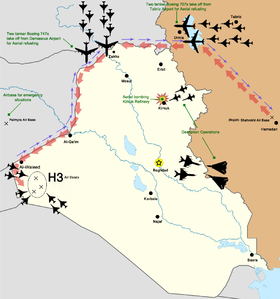| H3 airstrike | |
|---|---|
| Part of Iran–Iraq war | |
 Map of the attack | |
| Operational scope | Strategic |
| Location | Al-Waleed Airfield, Iraq 32°44′57″N 39°35′28″E / 32.749177°N 39.591186°E |
| Planned by | Major General Javad Fakoori (the commander of the IRIAF) General Hooshyar |
| Objective | Destruction of the Iraqi military aircraft |
| Date | 4 April 1981 |
| Executed by | |
| Outcome | Iranian Victory |
| Casualties | 45 Iraqi aircraft |
| |||||
The H3 airstrike was a surprise air attack by Iran during the Iran-Iraq War in April 1981, against the Iraqi Air Force at H3 Airbase.
Operation[]
An example of the refueling that happened during the mission

General Hooshyar, Assault Designer
In Saddam's attempts for a successful offensive against Iran on the northern front between 12 and 22 March 1981, Iraq fired two 9K52 Luna-M surface-to-surface Rockets against cities of Dezful and Ahwaz. Within days after this attack, commanders of the 31st and 32nd Tactical Fighter Wing in Shahrokhi Tactical Air Base (TAB 3, near Hamadan) planned a counterattack. According to Iranian intelligence, the Iraqi Air Force removed most of her valuable assets to its Al-Wallid air base on the Baghdad-Amman highway close to Jordanian border, part of H-3 complex.
For the operation against Al-Wallid, the 31st and 32nd Tactical Fighter Wings (TFW) employed F-4E Phantom crews, four F-14A Tomcats, one Boeing 747 airborne command post and three Boeing 707 tankers. Iran had noted that the interceptors of the Iraqi air defenses were usually not very active, especially not in Northern Iraq, so a plan was made to approach the Iraqi sites from that direction. Aside from Iraqi interceptors, Iranian pilots had to be careful to avoid SAMs in order to reach their target. Al-Wallid was almost 1500 kilometres from Hamadan, and Phantoms had to fly over Baghdad.
To increase their chances, Iranian commanders decided to fly their aircraft to Urmia Lake first, and then from there they would have a "clean" route passing over the mountains of Northern Iraqi-Turkish border. Since Phantoms could not reach their target without a number of aerial refueling, two Boeing 747 had to be sent to Syria in order to help the operation by meeting the strike group somewhere over western Iraqi border.
The operation began at 10:30am of the April 4, 1981. A formation of eight F-4E, accompanied by two airborne reserves started from Hamedan AFB (TAB 3) towards Urmia Lake and then after refueling over the friendly airspace they crossed into Iraq. a pair of F-14 Tomcats patrolled the area hours before the strike began and stayed there a few hours later to counter any probable retaliation from Iraqis. Two Boeing 747 tankers were deployed to Damascus airport in Syria a day before the mission begins. When the 8 phantoms were busy doing their first aerial refueling over Iranian air space, they receive the Go Ahead signal from Colonel Izadseta aboard one of the 747's in Syria, then they proceed to the target.
The Phantoms split their formation into two sections coming from several different directions and attacked different parts of the complex. First they bombed both runways at Al-Wallid in order to block any Iraqi fighters from taking off. In the meantime cluster bombs of the second group of Phantoms wrecked three large hangars, The Iraqi's still had not reacted in force, their anti-aircraft fire was weak, due to the surprise attack, thus the Phantoms had enough time to make multiple attacks and hit multiple targets with gunfire. Iran claimed that 48 Iraqi planes were destroyed or badly damaged by the end of the attack. however only one MiG-21 was damaged by the attack, in addition to some of the hangers damaged by the cluster bombs, which appeared to be empty hangers that were used to house aircraft previously, luckily, those aircraft were sent to other airbases that are closer to the Iranian front due to the ongoing war between the two countries.[1]
After the attack the Iranian formation turned back towards their own bases. No Iranian F-4E aircraft were damaged during the attack on Al-Wallid and although many Iraqi interceptors were scrambled toward them, none could catch up with Phantoms.
The Iranian attack against Al-Wallid is the most successful Iranian operation against any air base since 1967.
Iraqi air defense command later claimed that Syrian interceptors were helping Iranians during the attack, and their radar followed Phantoms for some 67 minutes.[2]

Major General Fakouri, Defence Minister
The Target[]
Location of H3 airbase was in the west of Iraq in heart of desert near Jordan-Arabia-Syria-Iraq borders and very far from Iran's borders, and was erected to secure the western boarders of Iraq, and was used in October War 1973.
H3 or (AL-Waleed) as Iraqi pilots used to refer, and due to the War between Iraq and Iran, was used as a support airbase for the Iraqi Air Force and housed not more than a few transportation squadrons,a squadron of MiG-21, as well as retired Hawker Hunters.[3]
according the Iranian intelligence, prior to the attack there were at least two squadrons equipped with ten Tu-22B and at least six Tu-16 heavy bombers as well as two other units with MiG-23BNs and Su-20s were hidden. those information proved to be wrong due to the Iraqi causalities in H3 although the attack was a surprise to Iraqis, and was carried secretly.
References[]
- ↑ The Power and the Strategic Role of the Iraqi Air Force 1931-2003 / Lt. General Alwan Alubosi {Chapter Three} Book
- ↑ Assault on Al-Wallid, Historical Iranian attack against H-3 base in 1981.
- ↑ Iraqi Fighters: 1953-2003: Camouflage & Markings ISBN 978-0615214146
The original article can be found at H3 airstrike and the edit history here.